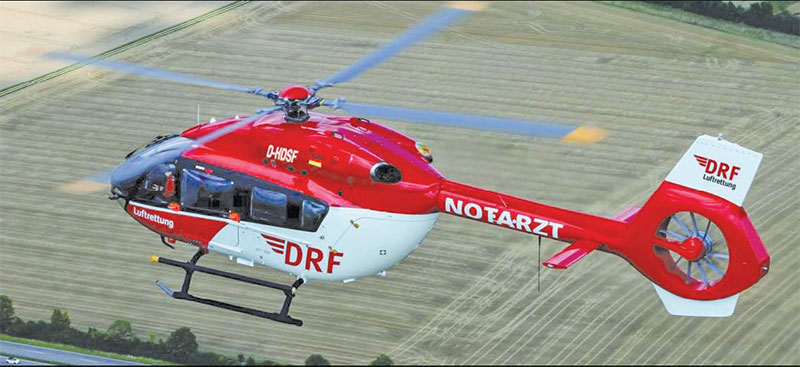HEMS operations in India still face significant obstacles
Yunus Dar | New Delhi
The Indian Helicopter Emergency Medical Services (HEMS) sector had a rough take-0ff. The country’s first dedicated helicopter emergency service Aviators Air Rescue (AAR), a Bengaluru-based company, launched on 16 December 2016, in partnership with Med-Trans Corporation (a subsidiary of Air Medical Group Holdings Inc, USA), failed to take off after it reportedly defaulted on payments to lessors and had to shut down. There are a number of reasons why HEMS isn’t doing good in India.

The global HEMS sector is a key market for helicopter manufacturers, along with Search and Rescue (SAR), and will remain a driver for future growth as markets like China and India begin to acquire more such helicopters. The HEMS accounts for more than half of the helicopter market in the world today, worth more than USD30 billion. The significant demand for new rotorcraft from HEMS companies helped the decline in the civilian helicopter market for quite some time now. The wide range of helicopters in this sector – single and light-twin engine – in the HEMS, which include the Airbus Helicopters H125, 130, 135 and 145; Bell 406, 407, 407BXP and 429; Leonardo AW169 and AW139; and the Sikorsky S-76D, have seen a considerable market in the sector.
While the growth in India has been sluggish, the global helicopter manufacturers such as Airbus Helicopters, Bell Helicopter, AgustaWestland, Sikorsky and Russian Helicopters pin their hopes on the developing economy, with an estimated market for 50 helicopters by the end of this decade. The demand for air-medical helicopters is expected to grow substantially after 2020.
A helicopter configured in the air-medical evacuation role with trained crew can quickly stabilise a critically ill or injured patient (on the ground or inside the helicopter), and then have them transferred to a hospital. India lags behind in offering this important emergency medical service compared to other developed countries, where the usage of helicopters for such roles is well established. The increasing urbanisation of major Indian cities marked by rapid and unplanned growth, along with high traffic density, makes the need for HEMS even more urgent.
The helicopters help in fast medical evacuation and surmount challenges such as natural obstacles, traffic snarls, and slow movement of traffic on narrow roads, which cannot be overcome by ground ambulances. The HEMS is not a substitute for ground ambulances, it only offers an enhanced capability and must be used for emergencies only, and not when a ground ambulance can perform the same task. For many in India, the sight of the armed forces being deployed to provide air evacuation during natural disasters and other emergencies, is a familiar one. The helicopters are often mobilised from nearby units and have to be flown down and are configured only for transport and not equipped with the specialised medical equipment available on a HEMS configured platform. These operations also consume precious flight hours on expensive military assets. The solution is to have air-medical helicopters available for such roles.
There are a host of other issues which also need to be tackled to enable the growth of this vital service, and the task is acknowledged as ‘difficult but necessary.’ The regulatory requirements also require to be changed and the Directorate General of Civil Aviation (DGCA) has been made aware of the requirements for the growth of HEMS in India. The time taken to receive clearance after filing the flight plan needs to be reduced, as this is vital to the quick response to an emergency call by an air-medical helicopter.
FORCE spoke to several experts on the subject, all of whom had similar views on what was preventing the sector to take off in the country. One expert who goes by the penname of Kaypius, an avid observer of the sector in India, says HEMS prospects will not change without the government stepping in and offering subsidy to the operators, with the state sponsors also jumping in to save the sector. He also says private investors need to step in and be willing to bleed to make the sector a success in India. Thirdly, it’s also the insurance companies who have to be willing to support the operators. Kaypius also notes that the government regulations need to be eased to make HEMS operations realistic for India. He says as of now, the Directorate General of Civil Aviation (DGCA) has cut copy pasted US regulations directly making it unviable and unrealistic in the Indian context.
The experts also opine the importance of airspace availability, which is crucial for HEMS operations to take off seamlessly. The opening up of the airspace is vital to the growth of helicopter operations. Opening up air-space below 5,000 feet should be seriously considered for the operations in this sector to be viable. China’s relaxation of low-altitude airspace, for example, set the foundations for the sector to flourish some years ago and is now a booming market for such helicopters. The country has taken the lead with regards to the setting up of HEMS with the delivery of the first fully-equipped air ambulance helicopter in China, an EC135 P2e, delivered by Airbus Helicopters a couple of years ago. It was the country’s first rotorcraft outfitted for dedicated HEMS missions, delivered to the 999 Emergency Rescue Centre which is a Beijing Red Cross Foundation subsidiary.
You must be logged in to view this content.

